MEDIA INFLUENCES
TELEVISION
AND
MOVIES
|
Any record of how banjo music evolved without at least touching on new
media influences would be incomplete. Though we cannot discuss all
the effects, we can point a few obvious ones which clearly did impact
the banjos popularity.
|
|
With the advent of the new media device, TV that soon spread to most
homes in the late 50s and early 60s in America it was just a matter of
time before banjo found a way on the air waves. Interesting to this author
was the path that led to this and also how it was seemingly cut short as well.
|
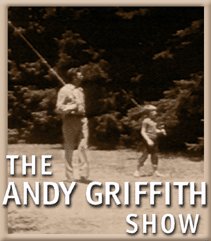 |
The Danny Thomas show on CBS piloted a new TV show, a series about a local
southern Sheriff raising a boy in a small hamlet in the south called Mayberry.
In October of 1960 the show premiered, and ran 249 episodes and has never
left the air in reruns since it began. |
|
The setting in this North Carolina
burg leads to a few visits from a clan of backwoodsman, led by the old
Pa of the family,(Played by Denver Pyle) and The Boys, the Darlins, ( the Dillards in real life ) became
one of the most beloved ensemble to join the show, doing 8 episodes over
the years. Doug Dillard on the fivestring playing in the new Scruggs style
offers many viewers a first look and see to bluegrass music.
| 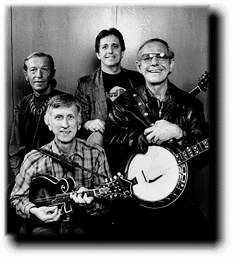 SoundClip
SoundClip
Banjo In The Hollow
The Dillards
|
|
Doug Dillard born out of East St Louis Illinois and then relocated to
the Ozarks in Missouri grew up with a musical family and learned to play both
fiddle and guitar as a youngster. He got to see Uncle Dave Macon play on an
Opry show and wanted a banjo from that time on. One Christmas when he was
16 he recieved a banjo as a present. He was thrilled, and burned
his initials into it right off, one of his brother recalled. He fumbled around learning 2 finger
style.The first time he heard Earl Scruggs
playing the banjo on the radio, he was driving down the road, and ran his
vehicle off into a ditch and had to be pulled out. He wrote Earl a letter
and asked if he was too old to learn. Earl replied to his letter and
gave him encouragement. As a young man, Doug pestered his parents into driving 500 miles
to see Earl, he boldly walked up to Earls door and knocked, and asked him
to help install Scruggs Tuners ( a tuner that allows quick tuning changes )
on his banjo. Earl came out and helped him and let him handle his own banjo.
Doug has always had a respect for Earl and his gentle manner.
Doug learned to play 3 finger style listening to Earls records
along with Don Reno and Ralph Stanleys records. He organized a band and played locally
and then in 1962 forming the Dillards, travelled to Hollywood and played
in an open mike engagement. An A&R man from Electra Records was there and signed
them up immediately. The Dillards aka the Darlins opened bluegrass to a wide
audience, this on the footsteps of another hit TV show that began in 62.
The Dillards performed on the Judy Garland Special and several other high profile
venues. Doug left the band in 1968 the band kept going and
recently Doug has returned and reunited they are currently playing together again.
A sidenote, this author once handled the banjo used on the Andy Griffith show, for details
see my short bio on this website.
|
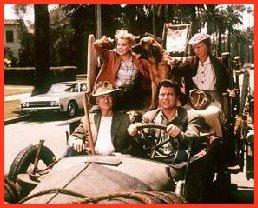 Soundclip
Soundclip
Ballad Of Jed Clampett
|
The Beverly Hillbillies, began airing in 1962 and ran nine years, and was
the number one show on the air the first two years it ran. The theme song
"Ballad of Jed Clampett" was written by Flatt and Scruggs, the first
bluegrass song to hit number one on radio.
|
|
This show became a showcase
for bluegrass licks, and Flatt and Scruggs were in several episodes.
One of the most memorable episodes was where both Flatt and Scruggs
were competing for the favors of Jeds sister Pearl, and a song called
Pearl Pearl Pearl was written. This became a big favorite of many.
Flatt and Scruggs were not the only musicians showcased,
banjoist, Roy Clark made a few appearances as well.
The Beverly Hillbillies, had a few spin off shows, Petticoat Junction
and Green Acres.
In 1968 Glen Cambell hosted a summer replacement show, and was so well
recieved he got his own show that ran 4 years. Glen had just had a hit
on a song called "Gentle On My Mind" written by banjoist John Hartford.
Glen featured alot of current country stars.
All of these shows were aired on CBS
CBS had enjoyed nearly a decade of
prosperity, being number one in the ratings. However the industry soon
began joking that CBS was an acronym for Country Broadcasting System.
This began to disturb some of the higher muckity mucks about their network
image.
|
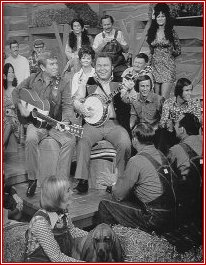 SoundClip
SoundClip
Cripple Creek
Buck Owens on Guitar
Roy Clark on Banjo
|
In 1969 CBS began a new variety show featuring country music,
bluegrass, and lots of corny humor. The show was called Hee Haw.
It featured co hosts Buck Owens a well established country and western
artist with a string of hits under his belt, and Roy Clark, banjoist,
and guitarist extrordinare like Buck a major star in his own rite
A regular feature was Pickin And Grinning Done by Buck on Guitar
and Roy on Banjo playing Cripple Creek, pausing to tell the corniest
jokes on TV. Along with the corn, Hee Haw sported some of the
best musicians in the world. Here were a few of their regular
cast banjoists.
|
| Dave StringBean Akeman, born on June 15, 1915 in Annville Kentucky
had entertained with Bill Monroes band years earlier. He was called Stringbean
because of his lanky appearance. Stringbean, a comedian and clawhammer style
banjoist lived just outside of Nashville Tennesee while working on Hee Haw.
His nearest nieghbor was co banjoist, comedian pal Grandpa Jones.
Stringbean had a running gag on the show reading a just recieved letter that
as he felt over his bibs searching pockets frantically, was close to his "heart heart
heart"
|
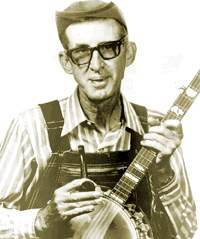 SoundClip
SoundClip
Dave Stringbean Akeman
Barnyard Picking
|
Tragically he
and his wife Estelle were murdered by a thief in 1973, as it was rumored he had placed
a large amount of cash in his home having been a depression era survivor
and not believing in banks. Grandpa Jones found them while making a scheduled visit
to their home.
Twenty years later, new residents of his home found twenty thousand
dollars hidden in the fireplace.
|
 Soundclip
Soundclip
Grandpa Jones
Fifteen Cents Is All I Got
|
Louis Marshall Jones, was born October 20, 1913 in Niagra Kentucky. His father being a sharecropper.
In his teens his family moved to Akron Ohio and he won a local talent
contest there that would launch his career. At 22 he was doing radio shows
and was given the name Grandpa by a co worker because he took so long
to come to the microphone when called. His voice made him sound older too
and soon listeners were writing in to find out just how old Grandpa was.
The nickname stuck.
|
Grandpa was in Germany in WW2, but after moved to Nashville where in 1947
he became a member of the Grand Old Opry. He like Stringbean was an original
Hee Haw cast member. One of his best bits was the "Hey Grandpa Whats For Supper?"
bit where he would recite a poetic feast of appalachian cullinary fare.
Grandpa was inducted into the Country Music Hall of fame in 1978, He suffered
a stroke in 1998 and passed away.
Grandpa played a Vega banjo and in the clawhammer style.
|
Mike Snider was a cast member of Hee Haw for 7 years. He has also
appeared on TNNs Prime Time Country and Nashville Now over 150 times.
Hes played over 1000 shows on the Grand Ole Opry. Hes made 8 albums.
He plays both clawhammer and Scruggs Style.
Mike is also a comedian, has written some comedy banjo songs
like Born To Shop, a tale of how his wife saving him money shopping, can spend money
far better than any thief could possibly steal it. His comedy and excellant banjo
playing are keeping him in the limelight in Nashville. |
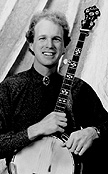 SoundClip
SoundClip
Mike Snider
John Henry
|
There were many other banjoists on the show from time to time too, these were
the regular cast members, along with Roy Clark. Mike and Roy both played on both Odes by Baldwin ,and Roy Clark began
endorsing Gibson Banjos in the 70s. Both Jones and Akeman played on Vegas.
The show ran on CBS from June 15, 1969 until July 31, 1971 and CBS cancelled it
even though it was always in the top 20.
All the programs Beverly Hillbillies, Petticoat Junction, Green Acres, Glen Cambells
Goodtime Hour, and Hee Haw and a few more successful show, were all given the ax
by CBS because they did not like being chided as the Country Broadcast Station.
Hee Haw went into syndication and continued to please audiences, for another 22 years. Its popularity did fade the last year
largely do to trying to reduce the country image of the show, they went city and the audience left them. But who can argue
with the success of any tv show that runs 24 years?
Back on CBS a decade later, the sound of a banjo playing was once again heard
via Larry McNeely on another show set in backwoods Appalachia, Dukes of Hazzard.
Sort of a cartoonish show featuring the narration of Waylon Jennings and stories
of bad cops and good ol boys.
A few movies worth mentioning too should be posted here. One mentioned
on the preceding page was Bonnie And Clyde a Warren Beatty film. Flatt
and Scruggs provided the soundtrack and Earls' Foggy Mountain Breakdown
became the movies themesong. That song is one of three most non bluegrass
people recognize. The most recognized by non bluegrass people is another
of Earls songs, The Ballad of Jed Clampett, and the third one is from another
movie. Made in 1972 it was called Deliverance a movie that played on
stereo types and depravity. There was a song done first recorded in 1955
by Don Reno, called Feuding Banjos, it was used in this movie called
Dueling Banjos, played by Eric Wiessberg and Steve Mandrell. This banjo
song being put in this movie to me was a two edged sword. It did alot to
promote bluegrass and banjos, but it also tied bluegrass to an image
that was sick and depraved.
A few more people that I feel should be mentioned, who did influence
and help popularize bluegrass banjos, from the media of television
and concerts were the following two men, both respected banjoists.
|
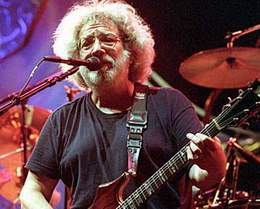
Jerry Garcia
| Jerry Garcia best known for his work with the band
that kept the hippie movement alive for 40 years The GreatFull Dead,
exposed tens of thousands of people to acoustic mountain and bluegrass
music in his concerts. Early in his life he experimented with bluegrass
as early as 1962 when it really began to spring up in the country with
the exposure on national television.
|
Jerry played on an old Weymanns Banjo
for along time before switching to the more popular Gibsons
For a more complete bio and history
of Jerrys Banjo adventures, CLICK HERE
to read Sandy Rothams account. Sandy an excellant banjoist himself
once a member of Bill Monroes band gives a detailed account, worth reading.
|
Steve Martin has many accolades associated with his name.
This multi talented man from Waco Texas learned to play
banjo early in his life, and entertained people at DisneyLand with his
banjo and magic act.
He became a writer on the Smothers Brothers Show when he was only 22
and won an emmy for his work.
|
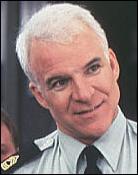
Steve Martin |
|
He wrote for many other tv celebrities,
but when he got onstage on NBCs television show, Saturday Night Live,
with an arrow through his head and his banjo, he opened up banjo music
to a huge new audience. Hes recorded 4 albums, and I believe one of them
is all banjo music. One of his most memorable bits he did with a banjo
was point out how hard it was to sing a sad song with a banjo, as it
is such a happy sounding instrument.
Steve plays both Scruggs and Clawhammer style banjo.
|
|
With all of this exposure, on national televsion and in the movies the interest in banjos spiked tremendously both in the US and
world wide. A plethera
of banjo manufacturers sprung up. Many of them in Asia. Banjos were being
made and sold in record numbers, however this fad would end even more
quickly than it began in the early 80s. Several banjo companies, simply
went out of business. Many banjoists today argue about why this happened,
many blame the media tieing the image of the banjo player to the backwoods,
depraved hillbilly, and the movement of the yuppies in the 80s to distance
themselves from that culture entirely. The image of the banjo player will
merit a page of script near the end of this compiltion. The truth may well
be, that banjo playing like cb radios and pet rocks, was just a short lived fad in the
late 70s.
|
MORE ABOUT
|

